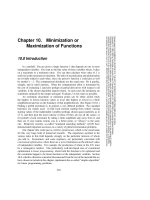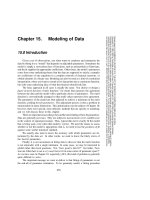Verilog Programming part 1 ppt
Bạn đang xem bản rút gọn của tài liệu. Xem và tải ngay bản đầy đủ của tài liệu tại đây (44.45 KB, 6 trang )
[ Team LiB ]
1.1 Evolution of Computer-Aided Digital Design
Digital circuit design has evolved rapidly over the last 25 years. The earliest digital
circuits were designed with vacuum tubes and transistors. Integrated circuits were
then invented where logic gates were placed on a single chip. The first integrated
circuit (IC) chips were SSI (Small Scale Integration) chips where the gate count
was very small. As technologies became sophisticated, designers were able to
p
lace circuits with hundreds of gates on a chip. These chips were called MSI
(Medium Scale Integration) chips. With the advent of LSI (Large Scale
Integration), designers could put thousands of gates on a single chip. At this point,
design processes started getting very complicated, and designers felt the need to
automate these processes. Electronic Design Automation (EDA)
[1]
techniques
began to evolve. Chip designers began to use circuit and logic simulation
techniques to verify the functionality of building blocks of the order of about 100
transistors. The circuits were still tested on the breadboard, and the layout was
done on paper or by hand on a graphic computer terminal.
[1]
The earlier edition of the book used the term CAD tools. Technically, the term
Computer-Aided Design (CAD) tools refers to back-end tools that perform
functions related to place and route, and layout of the chip . The term Computer-
Aided Engineering (CAE) tools refers to tools that are used for front-end processes
such HDL simulation, logic synthesis, and timing analysis. Designers used the
terms CAD and CAE interchangeably. Today, the term Electronic Design
Automation is used for both CAD and CAE. For the sake of simplicity, in this
book, we will refer to all design tools as EDA tools.
With the advent of VLSI (Very Large Scale Integration) technology, designers
could design single chips with more than 100,000 transistors. Because of the
complexity of these circuits, it was not possible to verify these circuits on a
breadboard. Computer-aided techniques became critical for verification and design
of VLSI digital circuits. Computer programs to do automatic placement and
routing of circuit layouts also became popular. The designers were now building
gate-level digital circuits manually on graphic terminals. They would build small
building blocks and then derive higher-level blocks from them. This process would
continue until they had built the top-level block. Logic simulators came into
existence to verify the functionality of these circuits before they were fabricated on
chip.
As designs got larger and more complex, logic simulation assumed an important
role in the design process. Designers could iron out functional bugs in the
architecture before the chip was designed further.
[ Team LiB ]
[ Team LiB ]
1.2 Emergence of HDLs
For a long time, programming languages such as FORTRAN, Pascal, and C were
being used to describe computer programs that were sequential in nature.
Similarly, in the digital design field, designers felt the need for a standard language
to describe digital circuits. Thus, Hardware Description Languages (HDLs) came
into existence. HDLs allowed the designers to model the concurrency of processes
found in hardware elements. Hardware description languages such as Verilog HDL
and VHDL became popular. Verilog HDL originated in 1983 at Gateway Design
Automation. Later, VHDL was developed under contract from DARPA. Both
Verilog
®
and VHDL simulators to simulate large digital circuits quickly gained
acceptance from designers.
Even though HDLs were popular for logic verification, designers had to manually
translate the HDL-based design into a schematic circuit with interconnections
between gates. The advent of logic synthesis in the late 1980s changed the design
methodology radically. Digital circuits could be described at a register transfer
level (RTL) by use of an HDL. Thus, the designer had to specify how the data
flows between registers and how the design processes the data. The details of gates
and their interconnections to implement the circuit were automatically extracted by
logic synthesis tools from the RTL description.
Thus, logic synthesis pushed the HDLs into the forefront of digital design.
Designers no longer had to manually place gates to build digital circuits. They
could describe complex circuits at an abstract level in terms of functionality and
data flow by designing those circuits in HDLs. Logic synthesis tools would
implement the specified functionality in terms of gates and gate interconnections.
HDLs also began to be used for system-level design. HDLs were used for
simulation of system boards, interconnect buses, FPGAs (Field Programmable
Gate Arrays), and PALs (Programmable Array Logic). A common approach is to
design each IC chip, using an HDL, and then verify system functionality via
simulation.
Today, Verilog HDL is an accepted IEEE standard. In 1995, the original standard
IEEE 1364-1995 was approved. IEEE 1364-2001 is the latest Verilog HDL
standard that made significant improvements to the original standard.
[ Team LiB ]
[ Team LiB ]
1.3 Typical Design Flow
A typical design flow for designing VLSI IC circuits is shown in Figure 1-1
.
Unshaded blocks show the level of design representation; shaded blocks show
p
rocesses in the design flow.
Figure 1-1. Typical Design Flow
The design flow shown in Figure 1-1
is typically used by designers who use HDLs.
In any design, specifications are written first. Specifications describe abstractly the
functionality, interface, and overall architecture of the digital circuit to be
designed. At this point, the architects do not need to think about how they will
implement this circuit. A behavioral description is then created to analyze the
design in terms of functionality, performance, compliance to standards, and other
high-level issues. Behavioral descriptions are often written with HDLs.
[2]
[2]
New EDA tools have emerged to simulate behavioral descriptions of circuits.
These tools combine the powerful concepts from HDLs and object oriented
languages such as C++. These tools can be used instead of writing behavioral
descriptions in Verilog HDL.
The behavioral description is manually converted to an RTL description in an
HDL. The designer has to describe the data flow that will implement the desired
digital circuit. From this point onward, the design process is done with the
assistance of EDA tools.
Logic synthesis tools convert the RTL description to a gate-level netlist. A gate-
level netlist is a description of the circuit in terms of gates and connections
between them. Logic synthesis tools ensure that the gate-level netlist meets timing,
area, and power specifications. The gate-level netlist is input to an Automatic Place
and Route tool, which creates a layout. The layout is verified and then fabricated
on a chip.
Thus, most digital design activity is concentrated on manually optimizing the RTL
description of the circuit. After the RTL description is frozen, EDA tools are
available to assist the designer in further processes. Designing at the RTL level has
shrunk the design cycle times from years to a few months. It is also possible to do
many design iterations in a short period of time.
Behavioral synthesis tools have begun to emerge recently. These tools can create
RTL descriptions from a behavioral or algorithmic description of the circuit. As
these tools mature, digital circuit design will become similar to high-level
computer programming. Designers will simply implement the algorithm in an HDL
at a very abstract level. EDA tools will help the designer convert the behavioral
description to a final IC chip.
It is important to note that, although EDA tools are available to automate the
p
rocesses and cut design cycle times, the designer is still the person who controls
how the tool will perform. EDA tools are also susceptible to the "GIGO : Garbage
In Garbage Out" phenomenon. If used improperly, EDA tools will lead to
inefficient designs. Thus, the designer still needs to understand the nuances of
design methodologies, using EDA tools to obtain an optimized design.
[ Team LiB ]
[ Team LiB ]
1.4 Importance of HDLs
HDLs have many advantages compared to traditional schematic-based design.
• Designs can be described at a very abstract level by use of HDLs. Designers
can write their RTL description without choosing a specific fabrication
technology. Logic synthesis tools can automatically convert the design to
any fabrication technology. If a new technology emerges, designers do not
need to redesign their circuit. They simply input the RTL description to the
logic synthesis tool and create a new gate-level netlist, using the new
fabrication technology. The logic synthesis tool will optimize the circuit in
area and timing for the new technology.
• By describing designs in HDLs, functional verification of the design can be
done early in the design cycle. Since designers work at the RTL level, they
can optimize and modify the RTL description until it meets the desired
functionality. Most design bugs are eliminated at this point. This cuts down
design cycle time significantly because the probability of hitting a functional
bug at a later time in the gate-level netlist or physical layout is minimized.
• Designing with HDLs is analogous to computer programming. A textual
description with comments is an easier way to develop and debug circuits.
This also provides a concise representation of the design, compared to gate-
level schematics. Gate-level schematics are almost incomprehensible for
very complex designs.
HDL-based design is here to stay.
[3]
With rapidly increasing complexities of digital
circuits and increasingly sophisticated EDA tools, HDLs are now the dominant
method for large digital designs. No digital circuit designer can afford to ignore
HDL-based design.
[3]
New tools and languages focused on verification have emerged in the past few
years. These languages are better suited for functional verification. However, for
logic design, HDLs continue as the preferred choice.
[ Team LiB ]
[ Team LiB ]
1.5 Popularity of Verilog HDL
Verilog HDL has evolved as a standard hardware description language. Verilog
HDL offers many useful features
• Verilog HDL is a general-purpose hardware description language that is
easy to learn and easy to use. It is similar in syntax to the C programming
language. Designers with C programming experience will find it easy to
learn Verilog HDL.
• Verilog HDL allows different levels of abstraction to be mixed in the same
model. Thus, a designer can define a hardware model in terms of switches,
gates, RTL, or behavioral code. Also, a designer needs to learn only one
language for stimulus and hierarchical design.
• Most popular logic synthesis tools support Verilog HDL. This makes it the
language of choice for designers.
• All fabrication vendors provide Verilog HDL libraries for postlogic
synthesis simulation. Thus, designing a chip in Verilog HDL allows the
widest choice of vendors.
• The Programming Language Interface (PLI) is a powerful feature that allows
the user to write custom C code to interact with the internal data structures
of Verilog. Designers can customize a Verilog HDL simulator to their needs
with the PLI.









